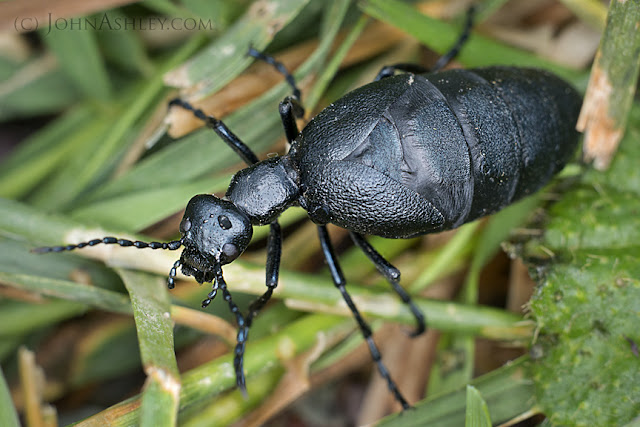 |
| Male Blister Oil Beetle (top) romancing a female |
( Romantic Valentine's Day issue - not! )
Gentle readers, rest assured that I am not devious enough to make up a tale this tall. No, the real-life story of some Blister Oil Beetles is almost beyond belief without any enhancement by me, your humble naturalist.
With that admonition, here we go. Through the creative use of cooperative behavior and sex pheromones, some species of Blister Oil Beetle (Meloe spp.) fool some Solitary Digger Bee species (subfamily Apinae) into delivering the beetles' larvae to the bees' nests, where the beetles eat the bees' food and the immature bees. And that's the censored version. Read no further unless you have a strong stomach and an open mind.
All of the Blister Oil Beetles that I've seen look like big black ants with extremely large butts (abdomens, actually). These are the adults, looking to mate and bury their eggs.
 |
| Male bleeding yellow, toxic cantharidin |
Sound familiar? Cantharidin is a chemical compound secreted by several beetle species - and one fly, the infamous "Spanish Fly" (Lytta vesicatoria). That's right, the alleged aphrodisiac of Cheech and Chong fame. In reality, cantharidin causes painful blistering and swelling of human skin. If ingested, it causes severe burning in the urinary tract and can easily be fatal.
How these beetles synthesize this poison is unknown, as is how they remain unaffected by it. But it's the young larvae of these aphrodisiac-producing, big-butt beetles who take sexual deception to a whole 'nuther level.
 |
| Males (top) have kinked antennae |
A male Digger Bee is chemically and visually attracted to this vibrating hunka' beetle larvae, and he lands to mate with "her." While he's busy (technical term, "psuedocopulation") many of the larvae latch onto tiny hairs on his belly until, either finished or flustered, he flies off in search of more "female bees."
Subsequently, each time he finds a real female bee to mate with, a cluster of beetle larvae disembark and clamber aboard the female. The impregnated female Digger Bee will soon dig a cave for her eggs and provision her young with honey and pollen. She also unwittingly delivers the predatory beetle larvae to her nest, where they'll settle in and proceed to eating the pollen and, often, eating her young bees as well.
Eventually, the well-fed triungulins in the bee nests will pupate in the soil and emerge as adult Blister Oil Beetles - with big butts. Brother and sister beetles find each other, mate, lay eggs, and the whole story gets all strange again.
If you don't believe me - and I don't know why you should - you can watch a short but stunning video of the Blister Oil Beetle's life cycle here (at the amazing ARKive site).
I hesitate to mention a different beetle species that grapples with Blister Oil Beetles in order to lick off the toxic cantharidin. The male offers the toxin as a nuptial gift to his mate, and she uses it to cover her eggs for protection against predation. No, that tale might actually be beyond belief.
 |
| Female Blister Oil Beetle (Meloe impressus) searching for a mate and/or a place to bury her eggs. |

